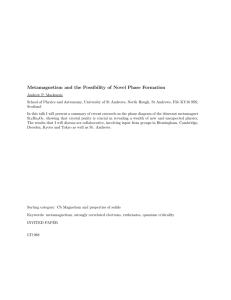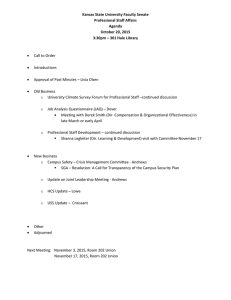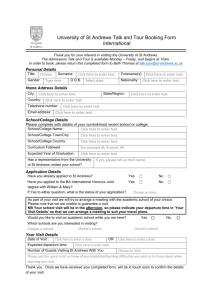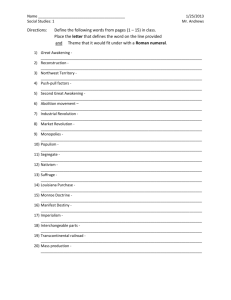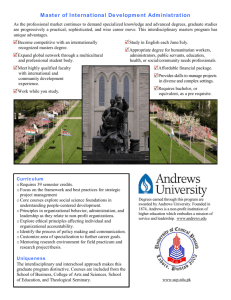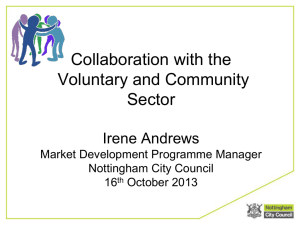Strategic Plan 20 March 2015 University of St Andrews
advertisement
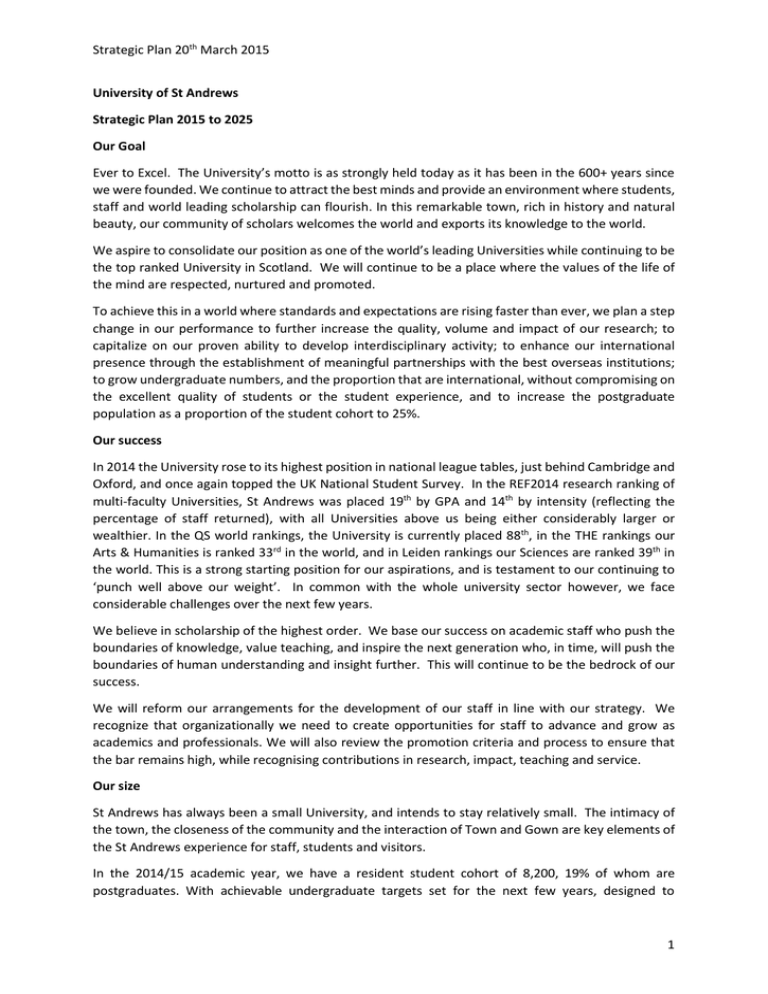
Strategic Plan 20th March 2015 University of St Andrews Strategic Plan 2015 to 2025 Our Goal Ever to Excel. The University’s motto is as strongly held today as it has been in the 600+ years since we were founded. We continue to attract the best minds and provide an environment where students, staff and world leading scholarship can flourish. In this remarkable town, rich in history and natural beauty, our community of scholars welcomes the world and exports its knowledge to the world. We aspire to consolidate our position as one of the world’s leading Universities while continuing to be the top ranked University in Scotland. We will continue to be a place where the values of the life of the mind are respected, nurtured and promoted. To achieve this in a world where standards and expectations are rising faster than ever, we plan a step change in our performance to further increase the quality, volume and impact of our research; to capitalize on our proven ability to develop interdisciplinary activity; to enhance our international presence through the establishment of meaningful partnerships with the best overseas institutions; to grow undergraduate numbers, and the proportion that are international, without compromising on the excellent quality of students or the student experience, and to increase the postgraduate population as a proportion of the student cohort to 25%. Our success In 2014 the University rose to its highest position in national league tables, just behind Cambridge and Oxford, and once again topped the UK National Student Survey. In the REF2014 research ranking of multi-faculty Universities, St Andrews was placed 19th by GPA and 14th by intensity (reflecting the percentage of staff returned), with all Universities above us being either considerably larger or wealthier. In the QS world rankings, the University is currently placed 88th, in the THE rankings our Arts & Humanities is ranked 33rd in the world, and in Leiden rankings our Sciences are ranked 39th in the world. This is a strong starting position for our aspirations, and is testament to our continuing to ‘punch well above our weight’. In common with the whole university sector however, we face considerable challenges over the next few years. We believe in scholarship of the highest order. We base our success on academic staff who push the boundaries of knowledge, value teaching, and inspire the next generation who, in time, will push the boundaries of human understanding and insight further. This will continue to be the bedrock of our success. We will reform our arrangements for the development of our staff in line with our strategy. We recognize that organizationally we need to create opportunities for staff to advance and grow as academics and professionals. We will also review the promotion criteria and process to ensure that the bar remains high, while recognising contributions in research, impact, teaching and service. Our size St Andrews has always been a small University, and intends to stay relatively small. The intimacy of the town, the closeness of the community and the interaction of Town and Gown are key elements of the St Andrews experience for staff, students and visitors. In the 2014/15 academic year, we have a resident student cohort of 8,200, 19% of whom are postgraduates. With achievable undergraduate targets set for the next few years, designed to 1 Strategic Plan 20th March 2015 maintain student quality while widening access, the UG population will grow by around 800 in the coming three years. With controlled expansion of our PG population, we will have more than 9,000 students by 2018. Further growth of our high quality overseas student population by exploring new markets could see our student cohort grow to 10,000 within 10 years, with over 50% of these being international and a post-graduate community of around 25%. Such growth will help us resist inflationary pressures on our costs and allow us to fund new projects. Such growth will however require investment in more teaching space, library facilities, student support services and residential accommodation. We will also continue to work with international partners, and will identify further partners, in order to increase the volume of activity across borders that enables increased access to the benefits of a St Andrews education, without all of that education having to be delivered in our small town. We will work closely with the community of St Andrews in delivering this growth. The excellence of the experience of St Andrews is in part built on the success of the town and the very strong Town and Gown relationship. In delivering growth, we will take care to do this sustainably, adding to the magic of St Andrews as a place. Our Approach The University is relatively small and will continue to operate a highly devolved structure, with decisions made at the most appropriate level, and as close to the point of service delivery as is possible, enabling colleagues across the institution to focus on what they do best: conduct research, teach, inspire, innovate, work together and demonstrate their professional expertise as appropriate to their occupation. To achieve this effective devolved management, we will continue to innovate collectively, maintaining our collegiate spirit, engaging and influencing across the whole community, consistently delivering on all fronts. We will continue to promote sustainable development throughout our community, in what we research, in what we teach and in how we behave. Our Context The University will continue to operate within the context of the Scottish Higher Education Sector. As an independent charity, we have a responsibility to ensure that our processes of governance meet the standards of an increasingly transparent world, while ensuring that the right decisions are made for the long-term prosperity of the University. We make a massive economic contribution to Fife and to Scotland, estimated in 2013 at £0.5billion annually. Independent analysis has demonstrated that for every £1 that the Scottish Government provides through teaching or research funding to St Andrews, we provide over £12 of economic benefit to the country. This demonstrates that public investment in St Andrews is genuinely an investment with a demonstrable and significant return, not simply another strand of Government spending. We will continue to focus on excellence. We recognize that one of the challenges for society is enabling mobility through the benefits of education. We have delivered much in improving the diversity of entrants to learning at St Andrews and will continue to do more. However, we also recognise that the barriers to such progression generally lie at the earlier stages in the development of students, and much must be done to raise aspiration levels for higher attainment. The Westminster and Scottish governments continue to deal with a prolonged period of economic hardship, with further restrictions on public spending in higher education likely through the first half of the planning period. In common with the HE sector, we will need to deal with anticipated significant 2 Strategic Plan 20th March 2015 cost growth driven by UK-wide salary settlements, changes in the UK fiscal regime for employment costs and the ongoing challenges of funding final salary pension schemes. The University will have to develop more efficient means of effective delivery of excellence in the future in order to meet the expectations of students and leading academics from a proportionately smaller funding base. The Scottish people recently considered making fundamental changes to their political autonomy. While the answer to the question posed was negative, we believe that in the coming years there will be an inevitable shift of power, influence and regulation to Scotland. We need to prepare for the additional challenges and opportunities that further devolution will inevitably bring and will continue to impress upon the Scottish government the benefits that a small global-leading University provides. Our People Our people should be our greatest asset. Our staff and our students are the lifeblood of what we do and how we do it. Their generation of knowledge, their provision of teaching, their support of others and the maintenance of our services is what sets us apart. We will continue to acknowledge and promote the benefits that diversity of ethnicity, faith, gender and orientation brings to the University community. We will work to ensure equal opportunity in all that we do, maintain diversity on committees across the University, remove gender pay gaps, work to redress the gender imbalance at professorial level and develop family friendly policies. Over the planning period, we do not expect the overall staff complement to change significantly, although the balance may alter slightly. We currently enjoy one of the most favourable student-staff-ratios (SSR) in the UK. While this undoubtedly contributes to our favorable NSS score, it is not sustainable as the student population grows. If there is no increase in academic staff numbers in the next 3 years, then our overall SSR will only increase from 11.5 to 12.5. This will continue to be one of the most favourable ratios in the UK. There is however considerable variation in SSR across the Schools and it will be important to manage SSRs across the institution as student numbers increase. Professional Services will continue to look to improve quality and effectiveness of what we do. We need to continue to focus on service delivery in a seamless manner, without the problems associated with organizational silos, where the end user doesn’t need to understand or need to navigate internal management structures. We will develop an institution in which things will simply be done well and without complication or hassle. Staff development is key to ensuring that the talents of our academic staff are being utilized to the full and that career pathways can be regularly discussed and planned. We will ensure that each School has an effective workload model to ensure fairness and equity across staff, and will introduce an annual academic review and development process that combines preparation for REF2020 and more holistic discussions about career development. In developing the skills of our staff, we will expect staff to embrace the opportunities for personal and professional growth and development, and in doing so, help to deliver transformative benefits to the University. We believe that we are the employer of choice in the local area, and we aim to continue to be so. Our Research World leading research quality remains at the heart of what St Andrews does. In REF 2014, the quality of our research outputs was regarded as being 14th in the UK and the top in Scotland. At the next REF exercise in 2020 we will aim to have more than 85% of our academic staff submitted with more than 3 Strategic Plan 20th March 2015 85% of outputs rated as 3* or 4*. It was clear from REF2014 results that Schools need to set a goal of achieving at least 30% 4* outputs to achieve a higher ranking, emphasizing the need to recruit only the highest calibre of academics and to ensure that staff focus their energies on publishing their very best research. We will aim to enhance the excellent research environment within our schools to ensure that it drives and inspires the work and ideas that give rise to world-class research. The ‘Impact’ component of REF is likely to grow in importance in REF2020 requiring us to invest now in planning and sharing best practice to ensure that we submit the strongest possible set of case studies. We will ensure that research support activities across the University provide the best possible professional service to help us achieve these goals. We will also achieve full compliance with funder requirements for open access publishing of outputs and data in order to maximise the visibility of St Andrews research. Our research management systems must continue to adapt to allow us to manage our outputs both internally and in the way they are presented to funding and research councils. We must be aware of both the policy landscape and the research integrity drivers for compliance in respect of open scholarship. This requires effective collaboration between the Research Policy Office, the Library, the Finance Office and Schools. Research funding remains a challenge given the growth in the university sector and relatively poor outcomes for RCUK in recent spending reviews. Nevertheless we might have expected a growth in research income given the expansion in our academic staff numbers in recent years. The Schools that dominate our annual research income (Biology, Chemistry & Physics) are doing as well as, or better than, their peers in the upper quartile of the Russell Group. Other Schools, however, need to show a dramatic improvement. We will expect all of our Schools to perform at or above the level of their peers in the Russell Group by the end of the planning period in terms of research grant funding. It is vital that Schools continue to work together to exploit interdisciplinary opportunities, consistently ensuring the vibrancy of our research environment and generating critical mass and strength that can compete for major funding opportunities to find answers to the major challenges facing the world. We will continue to seek outstanding international leaders for 7th-Century professorships and scholars who can join our current exceptional academics to help lead such interdisciplinary ventures. The University will provide support to enable the realization of the added value of collective endeavors that are enabled by multi-School and inter-disciplinary Centres and Institutes. These include access to larger project funding for collective research; opportunities to grow postgraduate teaching and training; enhancement of specialized research collections in the Library; and improved visibility to enhance external engagement and impact. Enhanced library provision will be supported by the establishment of a purpose-built storage and support facility at Guardbridge to ensure long-term security of our valuable assets together with efficient retrieval and delivery between this facility and the Main Library and Martyrs Research Library. In the Arts & Humanities, we enjoy a reputation of being amongst the world’s best. This strength has largely been an organic development, with individual international scholars being drawn together here, creating a rigorous and ambitious culture. A number of interdisciplinary world-leading institutes have subsequently formed, which further enhances our reputation in particular fields. Current examples include the well-established Handa Centre for the Study of Terrorism and Political Violence (Schools of International Relations and History) and the Institute for Mediaeval Studies (Schools of Art History, Classics, Divinity, English, History, Modern Languages and Philosophy). We will continue to prize individual research and scholarship but recognize that as a small university in a very competitive world we must be prepared to concentrate efforts and provide suitable frameworks for individual researchers through Centres and Institutes. These Centres and Institutes in the Arts, Humanities and 4 Strategic Plan 20th March 2015 Social Sciences require leadership from within the academic community in the pursuit of new levels of understanding and knowledge. New initiatives in the Arts and Humanities, involving the Schools of History and International Relations, include an Institute of Legal & Constitutional Studies and an Institute of War & Strategy, both of which will launch new distinctive MLitt programmes. The former integrates the legal and constitutional, the contemporary and the historic. The latter explores warfare and strategic studies from the mediaeval to the contempory. In Science & Medicine, the formation of interdisciplinary institutes has also been driven by academics around shared research imperatives. For example, scientists from the Schools of Biology, Chemistry, Medicine and Physics share purpose-built laboratory and office space in the highly successful Biomedical Sciences Research Complex (BSRC). The physical co-location provides an integrated, stimulating and supportive research culture that spawns new ideas and attracts the best researchers, a critical mass of scientists to compete for ambitious resources, and efficient management and delivery of laboratory support services. BSRC will continue to be the focus for research in infectious disease and molecular medicine. The Scottish Oceans Institute similarly involves scientists from a number of Schools (Biology, Chemistry, Mathematics & Statistics and Geography & Geosciences) with a focus on the blue bioeconomy. There is significant potential for substantial EU funding as well as excellent business engagement, building on the translational strength of the Sea Mammal Research Unit. In support of this, external funding will be actively sought to upgrade the East Sands site, to ensure it maintains its reputation as a modern, world-class marine biology Centre. We have a further specific goal to facilitate public engagement and opportunities and support for company spin-outs. Two new developments are at advanced planning stages and will be actively supported as they establish themselves. First, the Institute for Advanced Materials, building upon the world-class researchers in Chemistry and Physics, but also Biology and Geosciences, that will build on our considerable international expertise in new materials, focusing on material invention, application and fabrication. We see excellent opportunities for spin-out companies as well as the development of new degrees which will be particularly attractive to prospective applicants from countries with emerging economies. There will be significant opportunities for this research to accelerate the development of new technologies to tackle climate change in partnership with industry and other Universities. The second is an Institute for Discrete Mathematics, building on our strengths in computational algebra, combinatorics, probability, constraints programming and statistics, to pursue Discrete Mathematics, which is often viewed as the applied mathematics of the information era, in its broadest sense. The Centre, which will primarily involve Mathematics & Statistics and Computer Science, will facilitate both foundational theoretical research, and timely interactions with application areas. It will have impact across the Arts and Sciences, in diverse areas such as artificial intelligence, cybersecurity, economics and data science. Climate Change continues to present one of the most significant challenges facing mankind. As part of our contribution towards finding solutions to this, the University will become carbon neutral for its energy. The challenges however go even further than energy, with the efficient use of resources as important as sustainable energy around the world. Coupled with these international issues, the increasing focus on research impact in relation to public funding of research requires us to engage more fully in translational or knowledge transfer activities. The Guardbridge campus provides a unique opportunity in this respect to form industrial links, spin-outs and a platform for collaborative research 5 Strategic Plan 20th March 2015 with academic partners. There will be significant opportunities for engagement across the disciplines with Science, Social Science and the Arts & Humanities having real opportunities for meaningful engagement at a resource that will be unique in the UK. Our Teaching Teaching that is delivered in a world-class learning community, where top-level research influences educational design and practice, remains at the heart of St Andrews. We will continue to select excellent students of the highest academic calibre from a diversity of backgrounds, and support them to fulfil their potential as independent, analytical and thoughtful contributors to society. We will continue to develop our teaching curriculum, reflecting the increasingly strong qualifications of our entrants and adopting advances in research and teaching methodologies. We will maintain a balance between scheduled teaching and guided learning, such that students progressively develop a high degree of intellectual and organizational independence over the course of their studies. We will also adjust and monitor the portfolio of subject disciplines, collaborations, modes (such as e-learning) and timetabling of delivery as appropriate to the University’s needs, to respond to societal changes and to reflect the aspirations and abilities of our students. In line with our philosophy of research-led teaching, each of the research initiatives mentioned above can be expected to crystallize new opportunities for student recruitment. In particular, consideration will be given to more strategic development of the PGT portfolio, where for example new facilities at the Byre and Guardbridge may offer potential to develop programmes combining research-led instruction with the acquisition (during the dissertation or project) of sought-after practical/applied skills. Given our renewed commitment to interdisciplinary research, we shall review our interdisciplinary teaching and secure the future of our best interdisciplinary programmes at every level. The location, small size and close community atmosphere of St Andrews are central to the experience of the great majority of our students, including their intellectual development. Our teaching will remain founded on small group sizes to promote high quality exchanges in the classroom as well as the ready availability of world-leading staff to all students. We recognize that learning technologies and resources as well as the physical facilities have to be top class to continue to enable and inspire excellence. In order to support both classroom and independent learning, as well as preparing a secure and sophisticated platform for any future developments in distance learning, we will substantially update and improve use of the University’s Virtual Learning Environment and other learning technologies across the institution. Our international outlook is another key element of the education we provide. We will continue to explore collaborations with partners around the world and this will include expansion of study abroad, student and staff exchanges, as well as consideration of new ventures such as face to face teaching outwith traditional semesters where there is capacity to do so, joint degree programmes and elements of remote learning. As a priority, we shall seek to develop a flexible Natural Sciences Degree that may be jointly awarded with selected international partners, and designed to appeal as a Pre-Med qualification to prospective non UK Undergraduates. We recognize the importance of supplementing our core of intellectually demanding, research-led curricula with opportunities for students to acquire the skills and experience valued by society and employers. We shall therefore continue to expand internship opportunities within our Degree programmes, to embed employability skills in the curriculum wherever possible without compromising academic ambition, and to offer extra-curricular avenues for the development of highlevel professional skills. 6 Strategic Plan 20th March 2015 Our Facilities The expansion of student numbers, the need to further enhance the St Andrews Experience that is so appreciated by our students and the development of the new interdisciplinary institutes requires careful and imaginative estates planning. The growth in student numbers is likely to come mainly within the Arts & Humanities and the Social Sciences who are traditionally based in the Town Centre. We will seek to retain this focus of activity in the coming years. To create scope for this growth, we will need to be more innovative in the use of space by adapting some of our iconic older buildings for teaching, learning and research activities rather than their current use as service units. In parallel with this, we will create welcoming and imaginative facilities at Guardbridge to accommodate any decanted service units, ensuring a vibrant community is established where staff can enjoy a high level of job satisfaction. As well as increasing the range of formal and informal learning spaces for students in the town centre and on the North Haugh, we will continue with the development and expansion of the Main Library. With its long opening hours, access to heavily-used print material, extensive study accommodation provision, catering and at-seat power, the Main Library is the study location of choice for our students. To sustain its effectiveness, and meet growing demand, it will require to be remodelled to free up as much of the floorplate for study as possible, moving many staff and some stock to a new support facility at Guardbridge. In doing so, it will strive to upgrade its store retrieval service, and introduce ‘scan-on-demand’ from the store, to supply the needs of library users for non-immediate material as efficiently as possible. We will also seek to create special places in some of our historic buildings, such as the Bute, to enable creative multi-disciplinary engagement across traditional academic boundaries. In line with the growth in student numbers, and the commitment to work with the town to create sustainable growth, we will create additional student living accommodation along with better and larger facilities to support the wider student experience. We will increase our residential provision through a combination of our own investment and in partnership with others. We will continue our longstanding strategy of migrating all science schools (with the exception of the marine scientists) to the North Haugh to ensure that modern, fit for purpose facilities are available, which can be more easily adapted as the nature of science and the related engineering evolves. There is adequate scope on the North Haugh to accommodate the additional centres and this migration. Although no wholesale movement of any schools is currently envisaged in the planning period from the town centre, any new bespoke science facilities will be created on the North Haugh, rather than further adaptation of historic buildings which do not take well to adaptation for modern science. In recent years, the University has striven to achieve the highest standards in building sustainability with, for example, our most recent major science investment, the Wellcome Biomedical Science Research Complex being awarded BREEAM Outstanding, the first of such buildings to be given this rating in the UK. We will continue to demonstrate excellent sustainable development practice in our new buildings, in our refurbishments and in the way we use our buildings, continuing to improve energy and water efficiency even after carbon neutrality has been achieved. Our Professional Services Excellence in research & teaching is what St Andrews presents to the world. However, excellence is required throughout the University in all that we do, and it is essential that our Professional Services share this vision of excellence, wherever individuals sit within the organisational structure. The 7 Strategic Plan 20th March 2015 University has been at the forefront within the sector in recent years in improving and reforming its business processes. In many areas, our performance is excellent. We have also done much to change behaviours and infrastructure to tackle the emerging threats of cyber security. In the coming years, we will renew our focus in this area to transform the manner in which we conduct our business, removing many of the internal barriers that were created to deal with pressures long past. Clearance of these now unnecessary barriers will create opportunities for development of new skills and ways of working by all of our staff, to enable a more joined up and cross disciplinary, delivery of services. In time, this will also deliver a far more effective and efficient platform to underpin our world-class teaching and research and to enhance further the experience of the entire University community. Our Funding The funding position of the university will remain tight, as we seek to strike a balance between maintaining excellent student-staff-ratios, high levels of investment in materials essential for research and teaching and the provision of scholarships and bursaries, with the need for surplus generation for long-term investment. UK and Scottish Government policies will restrict tuition fee income from home and RUK students, and consequently such income will at best remain flat unless the fee cap is removed, with competition for academically talented RUK students intensifying. Compared to many of our competitors, our large overseas student population provides some financial stability, however the overseas market is also becoming increasingly competitive and provides us with additional challenges. Our increasing dependency on teaching income is clear, requiring careful planning. We will continue to maximize other sources of income to enable us to deliver and expand our core mission of excellent research and teaching. We expect continued growth in non UK teaching income, growth in research income of at least 25% and we expect to double the £25m or so that we generate as other income (not including student residences). When combined with efficiency savings in various areas and the benefits of business transformation activities we would expect to generate sufficient funds for capital investment from an annual surplus of between 3% and 5% of turnover year on year. Our Innovation and its Impact The ideas that have been born in St Andrews over the centuries have assisted in shaping the prosperity of society. In recent years our ideas have improved our understanding of how people think, how the oceans and the ecosystem behave under stress, have begun to harness light to heal wounds and advanced materials to deliver drugs within the human body. In a world that is becoming more mindful of the societal impact arising from new discoveries or knowledge, there is an increasingly short-term outlook. We must respond to this changing emphasis quickly and enthusiastically, maintaining our value and relevance to civic Scotland and beyond. However, in doing this, we must never overlook the significant long-term benefits of pure research. Through this, the collation of academic and industrial effort, both within and outwith our own community, we will accelerate development of new ideas and the enhancement of their usefulness to society. We will also increase the emphasis on enterprise within our community. We will build upon the strong enterprise culture of our undergraduates and promote this to our postgraduates and staff, creating pathways to have ideas developed, discoveries developed and marketed, and increase our profile in the realm of societal policy shaping. Our Community 8 Strategic Plan 20th March 2015 The sense of community centered on St Andrews is critical to our success. The University community – including alumni, sponsors, donors and friends – will be critical to assisting us in achieving our aspirations. We will continue to build upon our global family for fund and friend raising, for creation of internship and employment opportunities for our students and graduates and for innovation and investment opportunities for our ideas and inventions. Within our community, through their own activities in student societies and sport clubs, our students augment their academic development with additional skills in working with others, leadership and management of events. Bringing vibrancy to the town, as well as considerable voluntary work and charity fundraising, our students give much more back than is traditionally recognised. We will continue to assist and engage with the community in which we flourish. Our investments in becoming carbon neutral for our energy through the Biomass plant at Guardbridge and Kenly turbines will assist in reinforcing the energy infrastructure of the town and North east fife, lessening the risk of future power shortages and protecting jobs. The wider development of Guardbridge will bring a significant number of employment and investment opportunities which otherwise would not be available in this beautiful corner of Scotland. Our involvement in reopening the Byre Theatre in St Andrews will provide a significant and sustainable addition to the vibrant culture of North East Fife, significantly enhancing the quality of life for our neighbours and providing a valuable magnet to grow local tourism. We will also continue to enable local groups and societies such as the St Andrews Botanic Garden Trust in maintaining a tranquil space for townsfolk and the Pilgrim Trust in improving the natural amenity of the town centre by enhancing our own open spaces and enabling public access to them. The University of St Andrews brings much to our community. To the community within our classrooms, libraries and laboratories; to that community as it moves in and through life and the world; to the town and the local area; to Scotland, the UK and society in general. We have brought this vital and enriching benefit for 600 years. We will continue to do this for centuries to come. This Strategy outlines the next significant steps in this wonderful journey. 9
